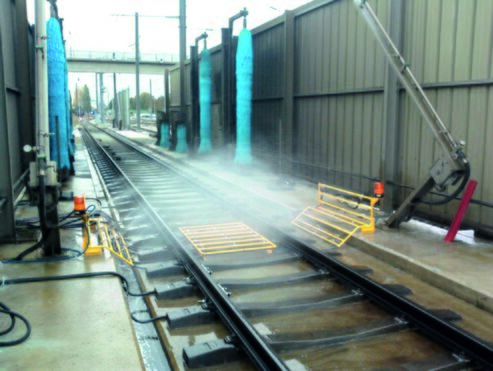Railway traffic de-icing

De-icing in railway traffic is both time and energy consuming. Ice prevention is done by either de-icing or anti-icing. De-icing means removal of accreted ice. Anti-icing means treating the material against ice formation. Both methods are used in railway traffic.
De-icing can be done by de-icing carts, that clear ice from tracks as they drive. Snow ploughs can also be used for the rails. For the train itself, there are deicing facilities, where hot water or chemicals like propylene glycol are used in de-icing. De-icing of rails and train carts can be done for example with electrical heating and using hot water to power wash the carts. Carts can be cleared with hot air blowers and compressed air for example.
One common de-icing weakness is the need to do it regularly. It has to be done frequently enough that the ice load never gets too big to hinder the operation. A related problem is the available de-icing capability, for example, the amount of de-icing washing facilities. If there is more icing than anticipated, the de-icing facilities cannot match the required de-icing speed. In this, anti-icing is needed, because it does not need an active application, but it is continuously in effect.
Strength of de-icing when compared with anti-icing, is that it can be responsive. When icing conditions get harder, the de-icing methods in use can be done more frequently, or with more power. Another strength over anti-icing is that anti-icing can be worn down, because it is always exposed to the elements. De-icing, especially active methods, are only applied when needed, so they do not need to be exposed.
Some railway companies have specialized trains to be used for ice clearance of the track. They have de-icing tools attached to them. These trains are equipped with snow ploughs, brushes or scrapers, and hot air blowers, steam jets and anti-freeze sprays.
Train carts are de-iced by washing them in. This washing can also include applying of antifreeze substances.
Hot water is efficient only for short term de-icing but can increase icing in the long term.
De-icing with glycol is an alternative to water, but glycol dripping from the train is another issue that needs to be taken care of.
Propylene glycol has been used for de-icing in aviation for years. It has been shown to be more effective than air or water in de-icing. Heated propylene glycol can be used the same way that water is used, sprayed at the ice-covered train. This would also leave propylene glycol on the train, which has an anti-freeze effect. The effect would only be temporary, because propylene glycol is water soluble, and would eventually be washed of by weather. But time needed for de-icing would be reduced. It is also more environmentally friendly than ethylene glycol.
References
- ↑ TRAIN ANTI-ICING SYSTEM, Railshine, webpage, available (accessed 4.3.2021): https://railshine.com/en/products/station-ferroviaire-antigivre/
- ↑ Niklas Kandelin: Icing Factors Affecting Railway Traffic Master of Science Thesis Tampere University Master’s Degree Programme, Materials Science October 2021
- ↑ Kloow, L. (2011). High-speed train operation in winter climate. KTH Railway Group Publication 1106.
- ↑ Wang, J. et al. (2018). A study of snow accumulating on the bogie and the effects of deflectors on the de-icing performance in the bogie region of a highspeed train. Cold Regions Science and Technology, 148, 121–130.
- ↑ Li, G. (2018). Fundamentals of icing and common strategies for designing biomimetic anti-icing surfaces. Journal of Materials Chemistry. A, Materials for Energy and Sustainability, 6(28), 13549–13581.
- ↑ Makkonen, L. (2012) Ice Adhesion -Theory, Measurements and Countermeasures. Journal of adhesion science and technology. [Online] 26 (4- 5), 413–445.
- ↑ Rolling stock anti-Icing, Nordic Winter Solutions, webpage, available (accessed 4.3.2021): http://www.nordicws.com/rollingstock/
- ↑ Fleet of de-icing trains deployed to keep railway lines open, The I and T, webpage, available (accessed 8.3.2021): https://eandt.theiet.org/content/articles/2019/01/fleet-of-de-icing-trains-deployedto-keep-lines-open/